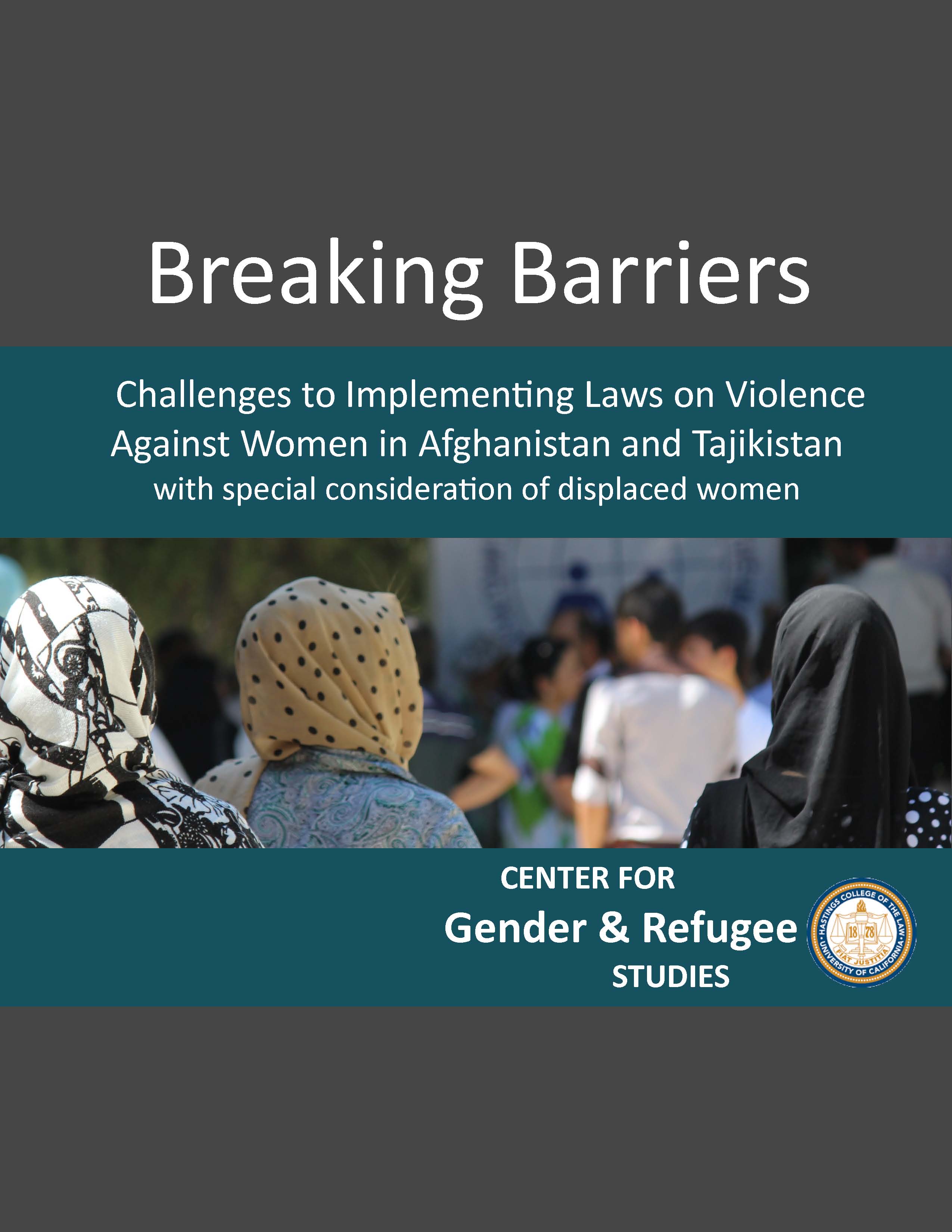Help Defend Asylum
CGRS relies on the generous support of people like you to sustain our advocacy defending the human rights of refugees. Make a gift today!
In 2016, CGRS published a new report, Breaking Barriers: Challenges to Implementing Laws on Violence Against Women in Afghanistan and Tajikistan with special consideration of displaced women, in collaboration with the Danish Refugee Council and with support from the United Nations Trust Fund to End Violence Against Women. The report may be downloaded at the links provided below and a summary of the findings and key recommendations follows. Read more about the project here.
Contents

Overview
CGRS published a comprehensive report that analyzes whether the laws in the Central Asian countries of Afghanistan and Tajikistan have effectively protected women from violence. The report, “Breaking Barriers: Challenges to Implementing Laws on Violence Against Women in Afghanistan and Tajikistan with Special Consideration of Displaced Women,” examines the challenges for Afghan and Tajik women experiencing gender-based violence, and in particular domestic violence. This is the first report to provide an in-depth study examining the implementation of Tajikistan’s Law on the Prevention of Family Violence (Family Violence Law), enacted in 2013. Specific attention is paid to women in situations of displacement, a subject that has previously received little attention.
Key Findings
CGRS’s key finding is that although the governments of Afghanistan and Tajikistan have made some modest efforts to enact and implement laws to address violence against women—buoyed by the creative and committed efforts of women’s rights advocates and civil society—violence persists at endemic levels due to deeply entrenched patriarchal norms viewing women as subservient to and the property of men. Six years after the enactment of the End Violence Against Women (EVAW) Law in Afghanistan, levels of violence against women continue to increase and criminal prosecution of such crimes remains low. Women fear increased violence and stigmatization if they report. CGRS Senior Staff Attorney and lead researcher and author of the report, Christine Lin, notes: “An alarming 87.2% of Afghan women, according to UN Women, have experienced some form of physical, psychological, sexual, or economic violence perpetrated predominately by family members. This is a stark figure and emblematic of the realities women are living in Afghanistan.” Indeed, returnee and internally displaced women are particularly vulnerable to violence as they lose traditional support mechanisms and face discrimination and isolation in their new communities. “The pervasive bias and discrimination against women at all levels of the justice system—from conservative lawmakers to prosecutors, police, and judges with responsibilities under the law—significantly impedes the EVAW Law’s implementation and will continue to do so unless addressed head on,” observes Ms. Lin.
Conditions for women in Tajikistan, including Afghan refugees, are similarly bleak. The 2013 Family Violence Law, while positive in some respects, is deeply flawed; the Law does not criminalize domestic violence, thereby diminishing the seriousness of the offenses. Spousal abuse is so commonplace that often it is not recognized as a problem. Male labor migration overseas, increased in recent years as a result of a weakened economy following Russia’s decline, exacerbates violence. While their husbands are abroad, women typically live with their in-laws, who treat them as household slaves and inflict psychological and physical abuse. “Even where the Family Violence Law does provide for protection mechanisms, such as restraining orders,” CGRS Co-Legal Director Blaine Bookey, a contributing author to the report, laments, “it utterly fails to provide clear instructions or processes for obtaining them, which has hindered the impact of the Law.” Like Afghanistan, pervasive bias and discrimination, as well as the scarcity of shelters, prevent women from pursuing safety or accountability for their abusers. Asylum-seeker and refugee women—the majority of whom are Afghan—face additional challenges when experiencing violence as they typically lack separate identity documents from male family members who accompany and financially support them.
Recommendations
The report concludes with extensive recommendations directed at the governments of Afghanistan and Tajikistan as well as civil society and international organizations and donors for how to prevent violence and reduce impunity for crimes of violence against women. “Bottom line,” Ms. Lin remarks, “is that, despite some efforts on the part of the governments, there is a long way to go and progress is slow. The Afghan and Tajik governments must prioritize trainings, clarify roles for relevant government actors, provide adequate temporary and long-term shelter options for women, allocate a sufficient budget, and create mechanisms for collecting and analyzing data on violence.” Ms. Bookey continues: “Without reliable data, the government obfuscates the depth of the violence and access to justice challenges women face, and that everyone knows exist, and avoids accountability for failed implementation of the laws.”
Acknowledgments
The report is the culmination of a two-year project—Women’s Empowerment in Afghanistan and Tajikistan for Displaced Persons through Legal Aid and Training to Combat Violence against Women—produced with funding from the United Nations Trust Fund to End Violence Against Women and in collaboration with Project Coordinator, the Danish Refugee Council, and partners Women for Afghan Women (Afghanistan), and Right & Prosperity (Tajikistan). In addition to original research analyzing implementation of the violence against women laws in each country, the project included trainings of lawyers and law students to increase legal aid capacity and access to justice for displaced and refugee women at risk of gender-based violence.
 Get help
Get help Log In
Log In




